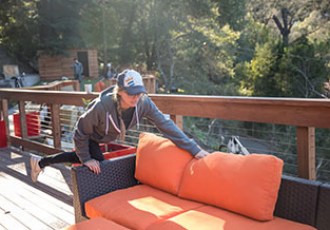We recommend these products based on an intensive research process that's designed to cut through the noise and find the top products in this space. Guided by experts, we spend hours looking into the factors that matter, to bring you these selections.

On a warm day, there’s nothing better than a relaxing dip in the pool. But depending on your style of pool, you may need some assistance getting in and out. Pool ladders feature slip-free surfaces on the steps, rungs, and railings to ensure you do so safely.
Pool ladders are ideal for both inground and aboveground pools. An aboveground pool especially needs a ladder due to its height off the ground (and it’s a far more cost-effective alternative to constructing a deck around it). Even if you have an inground pool with built-in steps, you’ll still likely want a pool ladder in the deep end or on the side. If you have children, you’ll be glad to know that some pool ladders are equipped with advanced safety features to prevent little ones from climbing in at any time.
If you’re ready to go for a dip and invest in a new pool ladder, our buying guide shares all the details on style, safety, and things to look for before purchasing your pool ladder.

Mounted styles take some work when it comes to installation. For starters, you’ll need to make accurate measurements, as they often require you to drill holes in order to permanently secure the ladder in place. While many pool ladders come with their own mounting kits, it’s not unusual to replace the original hardware with higher-quality pieces, or you may need to purchase additional hardware that may not be included.
Freestanding ladders are more often seen with aboveground pools. Due to their A-frame shape, they don’t always require mounting, as their weight is evenly distributed on both sides of the pool.
With so many differences in pool ladder styles, it’s no surprise that weight capacities also vary. Lightweight one-way ladders typically support up to 225 pounds. A-frames styles and large plastic ladders support as much as 400 pounds. While pool ladders could serve as makeshift seating, it’s a good idea to use the ladders mostly to get in and out of the pool.
Pool ladders are made of either metal or commercial-grade plastic — or a combination of both.
If you want a metal pool ladder, aim for mid-range models to avoid shoddy craftsmanship.
Less expensive plastic ladders could also be somewhat flimsy, especially A-frame models that aren’t permanently fixed to the ground. High-quality plastic ladders, on the other hand, feature the kind of durable plastic often used on public park equipment or for industrial purposes.
Combination ladders are a happy medium for the average backyard pool. They’re ideal if you don’t want to break the bank and are built with a reasonable degree of sturdiness that makes them last for several seasons at least. The most common styles alternate metal and plastic between steps and railings for a balanced, reinforced frame.
Pool ladders cost between $75 and $1,000. At the low end of the range, between $75 and $200, are ladders that are mostly made of metal. They have average-quality mounting, so if you’re looking for a more secure attachment, you’ll have to move up the price range. Mid-range models, priced between $200 and $300, include ladders made of durable commercial-grade plastic with advanced nonslip features and other unique pool-safety elements. If you’re looking at the top of the price range, between $300 and $1,000, you’ll find pool club-quality ladders or models that feature integrated gate systems. These deliver the best in quality and safety and could require expert assembly due to their advanced designs.

Q. Do I have to have a pool ladder for my aboveground pool?
A. In short, yes. It’s difficult — as well as dangerous — to get in and out of an aboveground pool without steps or a ladder. Some municipalities could inspect your pool or ask for proof of pool-ladder installation if permits are required. It’s a good idea to speak to your town’s permit office before installing an above ground pool to determine pool ladder requirements, so you can get your purchase right the first time.
Q. Will a pool ladder damage my pool or pool liner?
A. Many of the models we looked at were designed with rounded edges and smooth corners to prevent rips or tears to pool liners. You can also avoid accidental tears by making sure your pool ladder is properly secured and won’t rub or chafe the liner when people use it. For additional protection to your pool liner, there are pool ladder mats available. They affix to your liner and provide a cushioned surface that reduces the likelihood of tears.
Get emails you’ll love.
Learn about the products you’re wondering if you should buy and get advice on using your latest purchases.
